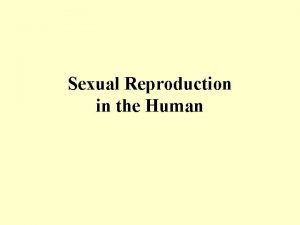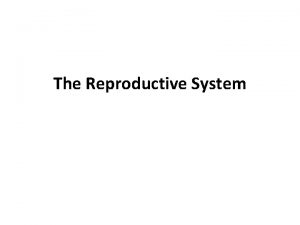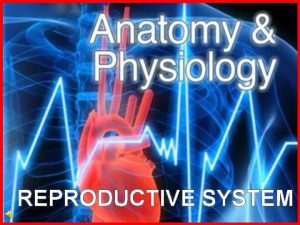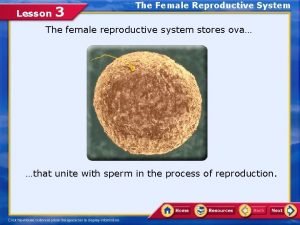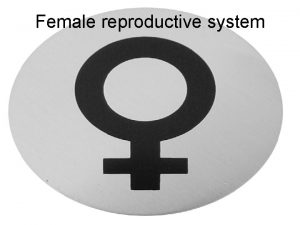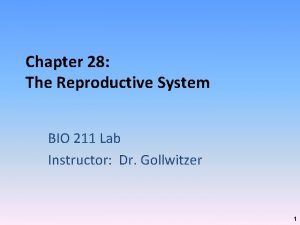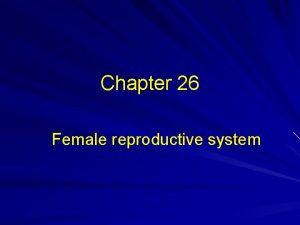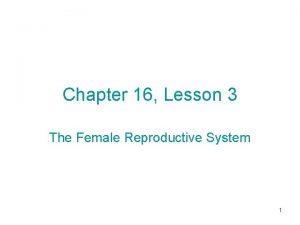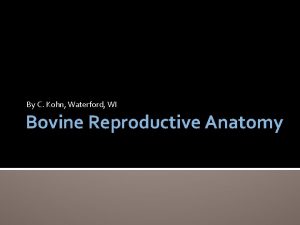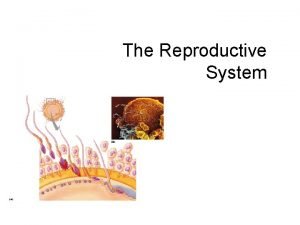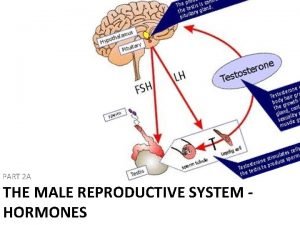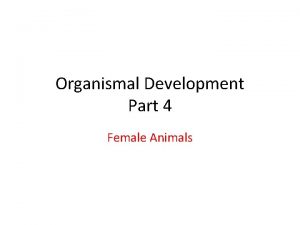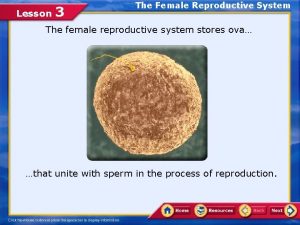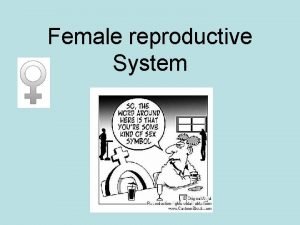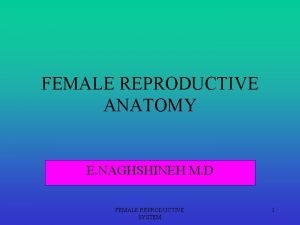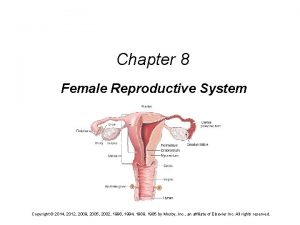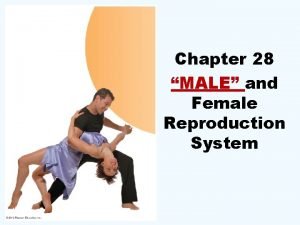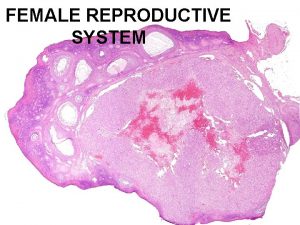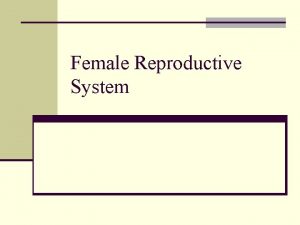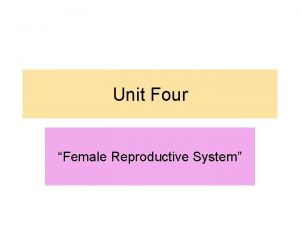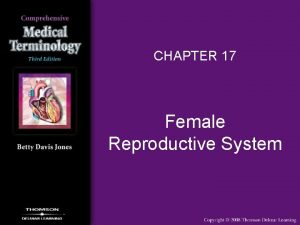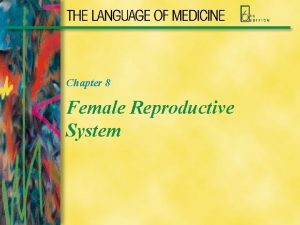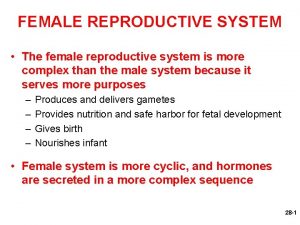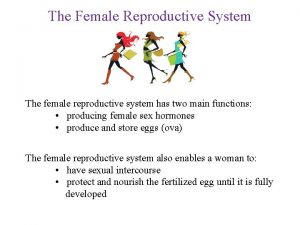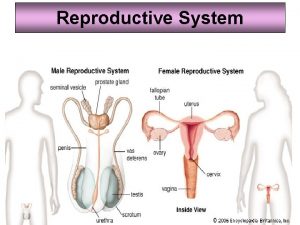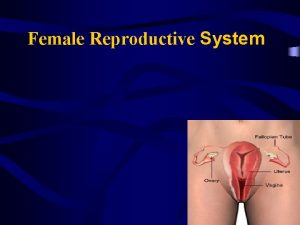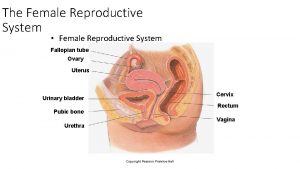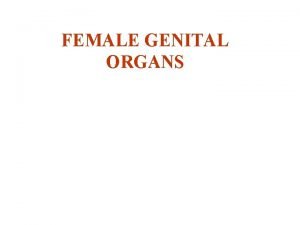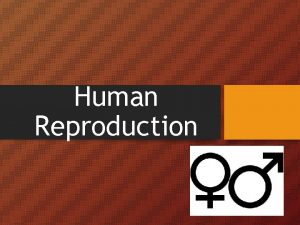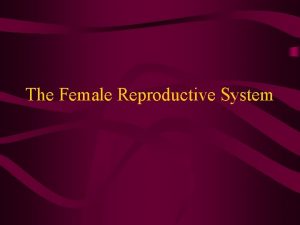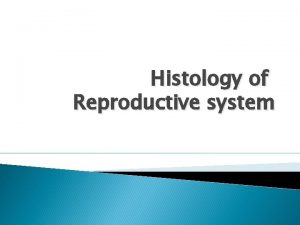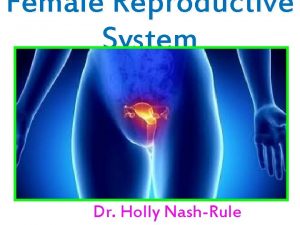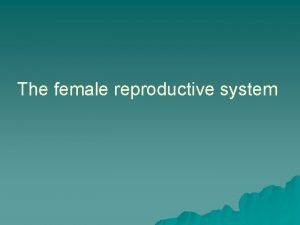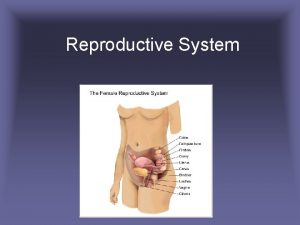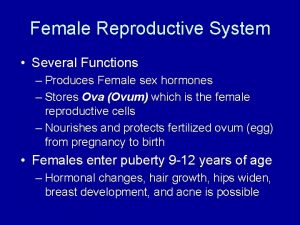The Reproductive System The female The Functions Produce


























- Slides: 26

The Reproductive System “The female”

The Functions • Produce female gametes to pair with the male’s • To provide protection and nourishment to developing offspring for several years • Secondary sex characteristics – Hip/waist ratio of. 7 – Development of breasts

Female Organs Essential Organs • Gonads in female are the ovaries • Female gametes are the ova, oocyte Accessory Organs • Uterine (fallopian) tubes • Uterus • Vagina • Vulva (external genitals) • Mammary glands http: //www. visiblebody. com/Brief. Overview. Male. Female. Movie

Perineum • Is in danger of being torn in childbirth which can lead to many complications • An episiotomy is sometimes done to prevent the damage caused by tearing

The Ovaries • Puckered almond-like shape • Anchored to the uterine wall by mesovarian ligaments • The distal portions of the uterine tubes cup the ovaries

Oogenesis • Beneath the epithelial layer of the ovaries are ovarian follicles • Each ovarian follicle contains an immature sex cell called an oocyte • Oocytes are surrounded by hormone releasing follicular (granulosa) cells • The oocyte goes through various stages until it is released as a mature ovum • Oogenesis results in only one viable ovum and 3 polar bodies

Functions of Ovaries • Ovary functions result in ovulation, release of ovum into the uterine tube • Ovaries secrete estrogen and progesterone, these regulate reproductive functions • Ovulation alternate between ovaries each month

Uterus • Pear-shaped in a woman who has never been pregnant • The top, wide part is referred to as the body • The bottom, neck part is referred to as the cervix • The bulge on top of the body is called the fundus

Uterus Layers • • • Endometrium – The inner lining that secretes mucus that acts as a barrier to sperm except during ovulation when it becomes slippery to facilitate sperm movement – Two upper layers are shed during menstruation and after delivering a baby Myometrium – Thick, smooth muscular layer – Smooth muscle is blended with connective tissue to give it elasticity and strength Parietal peritoneum – External layer that partially covers the uterus

Uterus Position • Normal position is anterior to rectum and posterior to bladder • The body normally rests superior to the bladder meeting the vagina at a right angle • Retroflexion is a backward tilt that can result in a prolapsed uterus

Uterine Functions • If fertilization occurs, the developing cell implants in the uterus (womb) • Specialized glands nourish the offspring until a placenta can develop • The placenta allows for the exchange of nutrients between mother and offspring • The myometrium contracts during childbirth • If no fertilization occurs then endometrium will shed during menstruation

Uterine Tube • • Also called fallopian tubes or oviducts There are three divisions – Isthmus extends out from uterus – Ampulla is the intermediate portions – Infundibulum is fringe-like projection that cups ovaries and opens into the peritoneal cavity, finger-like projections (fimbriae) collect the ovum • • Uterine tubes are the site of fertilization Tubal ligations prevent ovum from entering the oviducts

Ectopic Pregnancy • Ectopic pregnancy is any pregnancy that occurs outside the uterus

Vagina • Tubular organ that lies anterior to rectum and posterior to the bladder and urethra • It is approximately 7 to 8 cm long and capable of great distention • It is collapsible, lined with mucus membranes arranged in rugae

Vaginal Functions • Receptacle for sperm • Lower portion of birth canal • Transport of blood and tissue shed during menstruation

Vulva • Refers to external genitalia – Mons pubis- skin-covered layer of fat over the symphysis pubis – Labia majora- “large lips”, contain sweat and sebaceous glands, are homologous to the scrotum – Labia minora- “small lips” located medial to labia majora, the area between labia minora is referred to as the vestibule – Clitoris- homologous to the glans in the penis and is also covered by a prepuce – Urinary meatus- urinary opening situated between the clitoris and vaginal opening

The Breasts • Estrogen and progesterone stimulate the development of mammary ducts and secreting cells during puberty • Secreting cells are arranged in grape-like clusters whose ducts converge at the nipple • The ducts enlarge slightly into lactiferous sinus before reaching the nipple • The areola is the dark pigmented area around the nipple that contains many sebum glands

Self-Breast Exams • Should be done monthly a few days after the menstrual cycle • Look for unusual changes in appearance and color, especially dimpling or puckering of skin • Feel the breast using a pattern so that you cover all the areas • Sometime to the shower makes it easier to detect changes • Second most common cancer is young women, second most deadly

Lactation • Estrogen during pregnancy acts permissively on progesterone to prepare the breasts for lactation • Estrogen inhibits the function of prolactin • Shedding of placenta cuts off estrogen which stimulates the release of prolactin • Suckling of a baby stimulates prolactin and oxytocin • Milk secretion begins on the third or fourth day after delivery • Colostrum is yellowish secretion that is released before milk • Oxytocin stimulates the ejection of milk into the ducts


Benefits of Lactation • Perfect proportions of proteins, fats, calcium, vitamins and other nutrients • Passive immunity is conferred through mother’s antibodies in milk and colostrum • Enhances emotional bond between mother and child as well as further psychological development • Has been linked to – decreased allergies later in life – increased IQ – decreased risk of obesity

Ovarian Cycle • Before birth precursor cells undergo partial meiosis • After birth the female has many primary follicles each containing a oocyte • Once a month normally one oocyte migrates to the surface of the ovary and is released during ovulation • The ruptured follicle, called to corpus luteum, swells and begins to release estrogen and progesterone for 7 to 8 days • This process occurs 14 days before the next menstrual cycle

Menstrual Cycle Day 1 -5 – Menses or menstrual period Day 6 -13 – Post menstrual, post ovulatory phase – Increased estrogen levels cause mucus to become elastic Day 14 (28 day cycle) – Ovulation occurs – There is a decrease in basal body temp right before ovulation Day 15 -28 – Luteal phase or secretory phase – Corpus luteum secretes hormones during this phase


Menarche and Menopause • Menarche, menstration, usually begins around age 13 • Menses last for approximately 3 decades • Menopause begins between ages 45 -50 • Follicular cells are no longer responsive to estrogen

 Sperm duct
Sperm duct Figure of male reproductive system
Figure of male reproductive system Dog
Dog Duct system of female reproductive system
Duct system of female reproductive system Seminal tubules
Seminal tubules Female reproductive system with baby
Female reproductive system with baby Female anatomy
Female anatomy Epilization
Epilization Parts of male and female reproductive system
Parts of male and female reproductive system Unit 5 lesson 3 the female reproductive system
Unit 5 lesson 3 the female reproductive system Ovary diagram
Ovary diagram Uterus is part of which system in pila
Uterus is part of which system in pila Fetal pig urinary system labeled
Fetal pig urinary system labeled Figure 28-1 the male reproductive system
Figure 28-1 the male reproductive system Sagittal female reproductive system
Sagittal female reproductive system Chapter 16 lesson 3 the female reproductive system
Chapter 16 lesson 3 the female reproductive system Female cow reproductive system
Female cow reproductive system Cow reproduction system
Cow reproduction system Similarities between male and female reproductive system
Similarities between male and female reproductive system Female reproductive system internal
Female reproductive system internal Fsh and lh in female reproductive system
Fsh and lh in female reproductive system Corpus vagina
Corpus vagina Lesson 3 the female reproductive system
Lesson 3 the female reproductive system Female reproductive system color
Female reproductive system color External genitalia of female
External genitalia of female Chapter 8 female reproductive system
Chapter 8 female reproductive system Drawing of the male and female reproductive system
Drawing of the male and female reproductive system
